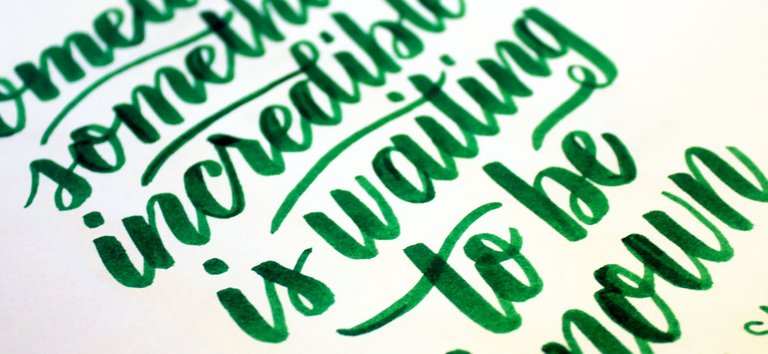– Photo by sharelettering.com –
Why Hand Lettering?
Ever since I was a kid, I was very interested in languages and art. I was five years old when my kindergarten teacher started to teach me how to write. When I first wrote the alphabet, I remember I didn’t want to make it boring so I added more curves and tails to the letters. Five years old and an alphabet “à la Roxana” – to me that“Freestyle Calligraphy” and as soon as I watched her videos and started doing some drills, I knew that it was a great investment and a new hobby of mine! I just enjoy it so much and have a lot of fun creating unique designs!
was cool. A few years later, as I was making my way to elementary school, calligraphy was part of my daily routine. My handwriting got even better. I would make my own hand lettered designs for school presentations. It made me express myself through an art discipline I was falling in love with! Time went by and... just last year I decided to take advantage of my creativity so I did the research and voilà ! I found Melissa Smith from @lissletters on Instagram. I bought her online course

Hand Lettering or Calligraphy? What’s the Difference?
I couldn’t have found a better answer to this question without Peggy Dean’s help – @thepigeonletters on Instagram.
“Hand lettering is the art of drawing letters in a spontaneous and decorative way. It uses multiple passes to create a single word or a phrase. But calligraphy is writing letters in an elegant and formal way. Its stroke goes over only once in a single pass to connect words or sentences”.
How to Begin?
Practice makes perfection. Practice makes the master. Practice makes progress. You’ve probably heard this before but this is so true and I’ll explain why. First, pick up the pen! Learning the basic strokes of hand lettering – thin up and thick down – is the fun part, I guarantee you. Second, embrace imperfection! Don’t be afraid to fail. Even if you think your own handwriting is awful or that it’ll be a complete mess, start from scratch and give yourself the opportunity to explore your skills! Third, nope. It is not an expensive hobby. I started my hand lettering journey with Crayola markers. They’re inexpensive and you can get them anywhere. You can even use regular pens! Finally, practice, practice and... more practice. Drills are the best way to master hand lettering and it also helps build up your style.
– Photo by The Lemonade Store –
The Tools: Let’s Talk About Pens and Paper...
There are so many options available out there. But like I mentioned before, you really only need one pen to start with. A waterbrush, paint or ink, watercolor paper, masking fluid is nice to have but not essential – says Melissa Smith. You don’t need to break the bank on hand lettering supplies to get you going. The important thing is to invest in versatile and tried-and-tested tools that can help you improve your art. Start with something small – buy a good-quality pencil or pen and paper. My favorite pens are: Pentel Touch (12 colors), Tombow Hard Tip, Tombow Soft Tip and Tombow Dual Brush (96 colors)
– Photo by The Pigeon Letters –

I hope you found this interesting and enjoyed this post as much as I did.
¡Hasta la vista, Steemians!
